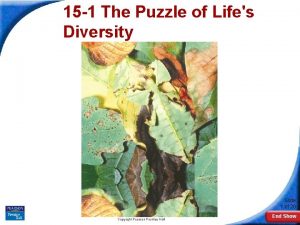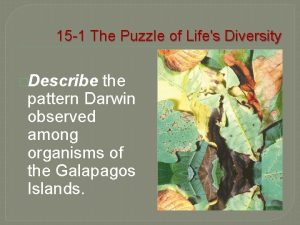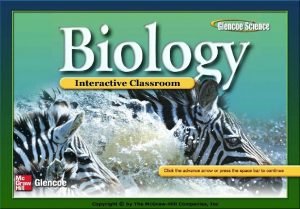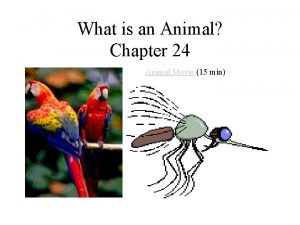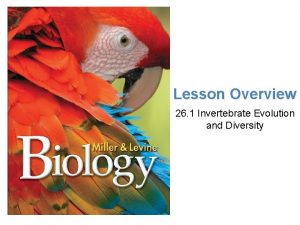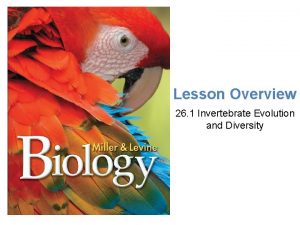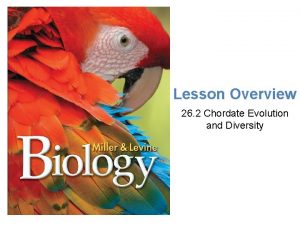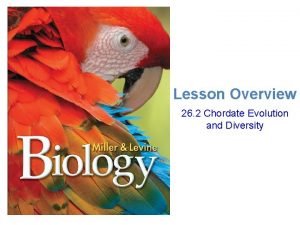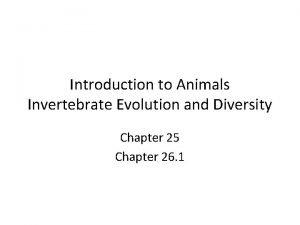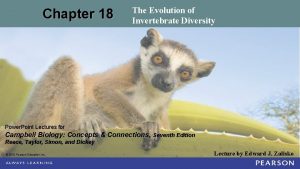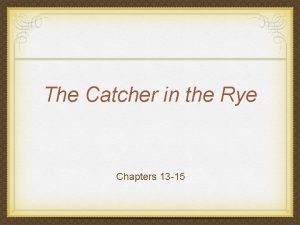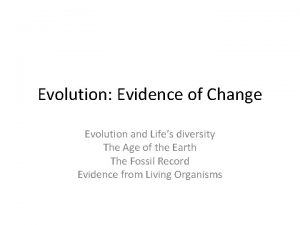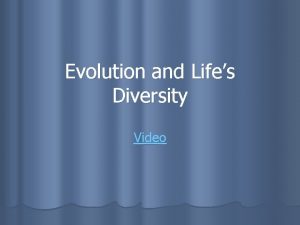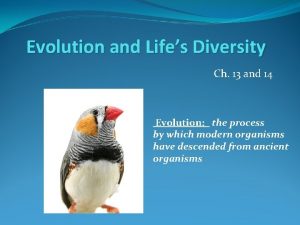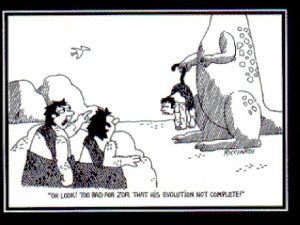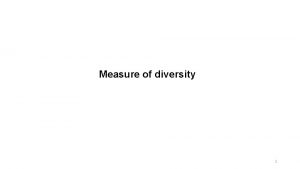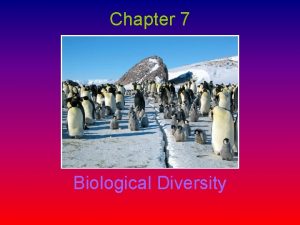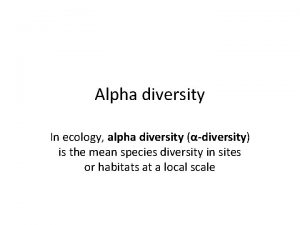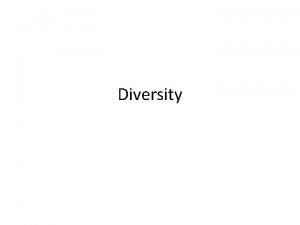Chapters 13 14 Evolution Evolution and Lifes Diversity





















































- Slides: 53

Chapters 13 & 14: Evolution

Evolution and Life’s Diversity • Scientists have accumulated considerable evidence to show that organisms alive today have been produced by a long process of change over time • The process by which modern organisms have descended from ancient organisms is called evolution • Charles Darwin contributed more to our understanding of the process than anyone else

Voyage of the Beagle • On December 27 th, 1831, H. M. S. Beagle sailed from England to survey the coast of South America • Charles Darwin was onboard • Darwin’s observations during his 5 years at sea changed the way we think of ourselves and our world

Voyage of the Beagle • During his journey, Darwin often left the ship to collect specimens of animals, plants, and fossils • He made careful observations and recorded them in a journal • What Darwin saw on his voyage led him to doubt the idea that species were constant

Above you can see the course of the Beagle, the ship in which Darwin sailed around the world. On this voyage, Darwin collected thousands of specimens of plants, animals, and fossils.

Fitness: To Survive and Reproduce • Darwin noted that most animals and plants have body parts and behaviors that do certain things very well • The physical traits and behaviors that enable organisms to survive and reproduce in their environment give them what Darwin called fitness

Darwin’s Mechanism for Evolution • Darwin returned to England in 1836 • He got married and wrote several books • For 20 years, Darwin gathered evidence supporting his ideas about evolution, but he did not publish them • Then in 1858 another biologist, Alfred Russel Wallace, sent Darwin an essay that presented these same ideas • This prompted Darwin to finally publish his work

Darwin’s Mechanism for Evolution • When Darwin’s book On the Origin of Species by Means of Natural Selection appeared in November of 1859, it stirred up great controversy • Darwin's conclusion that species changed over time and gave rise to new species contradicted the prevailing beliefs that God created all species and that species did not change

Darwin’s Mechanism for Evolution • In The Origin of Species, as the book is commonly known, Darwin not only presented much evidence that evolution occurred but also proposed that natural selection was its mechanism • Organisms with traits well suited to an environment are more likely to survive and produce more offspring than organisms without these favorable traits • This process is called natural selection

Darwin’s Mechanism for Evolution • Darwin’s views were soon accepted by biologists around the world • Since the discovery of Mendel’s ideas about genetics in the early 1900 s, genetic principles have been added to Darwin’s ideas, forming the modern theory of evolution

In 1859 Darwin published his famous book, The Origin of Species. He accomplished much of his work in his study at Down House in Kent, England.

Understanding the Fossil Record • More than a century has passed since Darwin’s death in 1882 • During this period, a great deal of new evidence has accumulated supporting theory of evolution • This evidence has come from a variety of sources, including studies of fossils, comparisons of the structures of organisms, and the rapidly expanding knowledge about DNA and proteins

Fossils are any Traces of Dead Organisms • Most people think of fossils as shells or old bones • Actually, fossils are any traces of dead organisms • Tracks of dinosaurs, footprints of human ancestors, insects trapped in sticky tree sap, impressions of leaves or skin, and animals buried in tar are all fossils • Both biologists and geologists date the Earth’s past with the help of a record in the rocks called the geologic time scale

Fossils are any Traces of Dead Organisms • Relative dating is a technique used by scientists to determine the age of fossils relative to other fossils in different layers of rock • For fossils to form, very special conditions are necessary • If a skeleton or shell is to fossilize, the dead animal must be buried by sediment • Calcium in the bone or in the shell is slowly replaced by other, harder minerals • The fossil record provides only a glimpse into life’s history

How Fossils are Dated • Since the late 1940 s scientists have been able to determine the ages of rocks and fossils by measuring the amount of radioactive decay, or breakdown, of radioactive atoms in the rock • A radioactive atom contains an unstable combination of protons and neutrons • Since it is unstable, a radioactive atom will eventually change into a more stable atom of another element

How Fossils are Dated • For example, carbon-14, a rare form of carbon found in tiny amounts in living things, decays into nitrogen • The term half-life describes how long it takes for one-half of the radioactive atoms in a sample to decay • Since carbon-14 decays relatively rapidly, other isotopes with longer half-lives are more often used to date fossils

How Fossils are Dated • Because the rate of decay of a radioactive element is constant, scientists can use the amount of radioactive element remaining in a rock or fossil to determine its age • This technique is called radioactive dating • Evolution can be a very slow process; the transformation of one species into another by natural selection requires thousands of years • Using radioactive dating, scientists have determined that the Earth is about 4. 5 billion years old

How Fossils are Dated • By combining radioactive dating, relative dating, and observations of important events in the history of life on Earth, scientists have divided the 4. 5 billion years into large units called eras • Eras are further divided into periods, which are in turn divided into epochs

The Fossil Record • Most fossils are found in sedimentary rock – Formed when exposure to rain, heat, and cold breaks down existing rocks into small particles of sand, silt, and clay • The chancy process by which organisms are fossilized means that the fossil record is not as complete as we would like it to be • For every organism that leaves a proper fossil, many die and vanish without leaving a trace

The Fossil Record • The quality of fossil preservation also varies • Some fossils are preserved so perfectly that we can see the microscopic structure of tiny bones and feathers • Other fossils are not preserved as well and so raise fascinating questions about their meaning and importance

What the Fossil Record Tells Us • Scientists who study fossils are called paleontologists • Over the years, paleontologists have collected millions of fossils to make up the fossil record • The fossil record represents the preserved collective history of the Earth’s organisms • Although incomplete, the fossil record has long inspired scientists

What the Fossil Record Tells Us • Paleontologists have assembled good evolutionary histories into many animal groups • The fossil record also tell of major changes that occurred in Earth’s climate and geography • As Earth’s environments changed over time, many species died out • The fossil record shows that change followed change on Earth

Similarities in Early Development • Much of our evolutionary history can be seen in the way human embryos develop • Early in development, human embryos and embryos of all other vertebrates are strikingly similar • In later stages of development, a human embryo develops a coat of fine fur • The similarity of these early developmental forms strongly suggests that the process of development has evolved • New instructions on how to grow have been added to old instructions inherited from ancestors


Comparing Organisms • Comparing the way organisms are put together provides important evidence for evolution • Your arm appears quite different from the wing of a bird or the front fin of a dolphin • Yet you can see that the position and order of bones in these limbs are very similar • Biologists say that these three limbs are homologous • Homologous structures are structures that share a common ancestry • They are modified versions of structures that occurred in a common ancestor


Vestigial Structures are Clues to Evolutionary Origins • Structures without function are found in living things • A whale propels itself with its powerful tail and has no need for hind limbs or the pelvis to which they attach • Nevertheless, whales still have a reduced pelvis that serves no apparent function • Structures with no function are known as vestigial structures • Vestigial structures are remnants of an organism’s evolutionary past • The whale’s pelvis is evidence of its evolution from four-legged, land-dwelling mammals


Transitional Forms Link New Species to Old • Because new species form from existing species, Darwin predicted that transitional forms, intermediate stages between older and newer species, would be found in the fossil record • There are now many good examples of evolutionary transitions • For instance, modern whales are the descendants of four-legged land animals that are also the ancestors or horses and cows • Fossil intermediates between modern whales and their 60 million year old ancestor reveal a history of slow transformation • Over time, the hind limbs became smaller and smaller, until eventually they were lost entirely

Modern whales have forelimbs that are flippers, no hind limbs, and a tiny, nonfunctional pelvis. Rodhocetus kasrani probably spent little time on land. Its reduced hind limbs could not have aided in walking or swimming. Ambulocetus natans apparently walked on land in a manner similar to modern sea lions. It swam by flexing its backbone and paddling with its hind limbs. Mesonychids are the hypothesized link between modern whales and hoofed mammals.

DNA and Proteins Contain Evidence of Evolution • Although complete fossil histories for living organisms are rare, an organism’s history is written in the sequence of nucleotides making up its DNA • If species have changed over time, their genes should also have changed • The theory of evolution predicts that genes will accumulate more alterations in their nucleotide sequence over time • Thus, if we compare the genes of several species, closely related species will show more similarities in nucleotide sequences than will distantly related species

What Homologies Tell Us • The structural and biochemical similarities among living organisms are best explained by Darwin’s conclusion: Living organisms evolved through gradual modification of earlier forms – descent from a common ancestor

How Natural Selection Causes Evolution • Darwin not only demonstrated that evolution has occurred but also proposed its principal mechanism – natural selection • The key factor in natural selection is the environment • The environment presents challenges that individuals with particular traits can better overcome • Thus, the environment “selects” which organisms will survive and reproduce more often

Evolution by Natural Selection • Individuals whose characteristics are well -suited to their environment survive • Individuals whose characteristics are not well-suited to their environment either die of leave fewer offspring – Survival of the fittest


The Peppered Moth: Natural Selection in Action • Over many generations natural selection gradually changes a species in response to the demands of its environment • Adaptation is the process by which a species becomes better suited to its environment • Adaptation can also refer to any change in a trait that increases the likelihood that an organism will survive or reproduce

The Peppered Moth: Natural Selection in Action • Until the 1850 s, dark gray peppered moths were rare and were treasured by British butterfly and moth collectors • Almost all peppered moths were pale • Around 1850, dark peppered moths started to become more common, usually in heavily industrialized areas • By 1950, peppered moth populations living near industrial centers consisted almost entirely of dark individuals

The Peppered Moth: Natural Selection in Action • Why did the dark peppered moths become more common? • Darwin’s theory of evolution by natural selection suggests a hypothesis • The color change coincided with a great increase in the number of factories in England • Pale tree trunks were blackened by heavy pollution from these factories • Perhaps dark moths sitting on soot-darkened bark escaped being eaten by birds because it was hard for the birds to see them

The Peppered Moth: Natural Selection in Action • Light-colored moths, on the other hand, would have stood out against a dark background and would have been easily spotted by hungry birds


Evolution as Genetic Change • In order to describe the evolution of plants and animals, modern evolutionary biologists study groups of organisms called populations • Because all members of a population can interbreed, they and their offspring share a common group of genes, called a gene pool • The number of times an allele occurs in a gene pool compared with the number of times other alleles for the same gene occur is called the relative frequency of the allele • Evolutionary change involves a change in the relative frequencies of alleles in the gene pool of a population

The Development of New Species • Organisms, like members of a human community, need to survive and acquire the necessities of life • The combination of an organism’s job and the place in which it lives is called its niche • No two species can occupy the same niche in the same location for a long period of time • Chances are, one of the species will be more efficient than the other • The more efficient species will survive, reproduce, and drive the less efficient species to extinction

The Process of Speciation • New species evolving from old ones is called speciation • Individuals of the same species share a common gene pool • One of the most common ways in which new species form is when populations are separated • The separation of populations so that they do not interbreed is called reproductive isolation

How Species Form • Because natural selection favors changes that increase an organism’s chances of surviving and reproducing, it will continuously shape a species to improve the fitness between the species and its environment • When populations of a species are found in several different kinds of environments, natural selection will act to make each population suited to its particular environment

Darwin’s Finches • Darwin repeatedly saw patterns in how kinds of animals and plants differed, patterns suggesting that species changed over time and gave rise to new species • On the Galapagos Islands, 600 miles from the coast of Ecuador, Darwin collected several species of finches • All of these species were similar, but each was specialized to catch food in a different way

Darwin’s Finches • Some species had thick, sturdy bills for cracking open tough seeds • Others had slender bills for catching insects • All of the species of finches closely resembled one species of South American finch • In fact, all of the plants and animals of the Galapagos Islands were very similar to those of the nearby coast of South America

Darwin’s Finches • If each one of these plants and animals had been created to match the habitat of the Galapagos Islands, why did they not resemble the plants and animals of islands with similar environments that lie off the coast of Africa? • Why did they instead resemble those of the adjacent South American continent?

Darwin’s Finches • Darwin felt that the simplest explanation was that a few organisms from South America must have migrated to the Galapagos Islands in the past • These few kinds of animals and plants then changed over the years that they lived in their new home, giving rise to many new species

The woodpecker finch captures insects with its grasping bill. The crushing bill of the large ground finch enables it to feed on seeds. The cactus finch uses its probing bill to feed on cactuses.

Speciation and Adaptive Radiation • The process in which one species gives rise to many species, as with the finches, is called adaptive radiation or divergent evolution • During a period of adaptive radiation, organisms evolve a variety of characteristics that enable them to survive in different niches

Does Evolution Occur in Spurts? • Following Darwin’s lead, most biologists have assumed that species formation is a slow, gradual process that goes on all the time • The hypothesis that evolution occurs at a slow, constant rate is known as gradualism

Does Evolution Occur in Spurts? • Recently, some biologists have challenged gradualism, arguing that species formation occurs rapidly after major environmental upheavals • Short periods of rapid species formation have been followed by long periods during which little evolution occurred • The hypothesis that evolution occurs at such irregular rates is known as punctuated equilibria

 Section 15-1 the puzzle of lifes diversity
Section 15-1 the puzzle of lifes diversity Section 15-1 the puzzle of lifes diversity
Section 15-1 the puzzle of lifes diversity Chapter 17 section 1 the history of classification
Chapter 17 section 1 the history of classification Circle lifes
Circle lifes 4 lifers
4 lifers Song count your blessings
Song count your blessings Genetic diversity vs species diversity
Genetic diversity vs species diversity Ecosystem jigsaw activity
Ecosystem jigsaw activity Tiburonia granrojo
Tiburonia granrojo Lesson 4: invertebrate evolution and diversity: 1
Lesson 4: invertebrate evolution and diversity: 1 Lesson 5: invertebrate evolution and diversity: 2
Lesson 5: invertebrate evolution and diversity: 2 26.2 chordate evolution and diversity
26.2 chordate evolution and diversity Fish tail bird
Fish tail bird Snail phylum
Snail phylum Chapter 18 the evolution of invertebrate diversity
Chapter 18 the evolution of invertebrate diversity To kill a mockingbird chapter 10-11 summary
To kill a mockingbird chapter 10-11 summary How to kill a mockingbird chapter 1 summary
How to kill a mockingbird chapter 1 summary Noughts and crosses book summary
Noughts and crosses book summary Characters in chapter 3 great gatsby
Characters in chapter 3 great gatsby Dr jekyll and mr hyde chapter 4
Dr jekyll and mr hyde chapter 4 The children were too flabbergasted
The children were too flabbergasted Chapter summaries of to kill a mockingbird
Chapter summaries of to kill a mockingbird Scarlet letter chapter 11
Scarlet letter chapter 11 Pride and prejudice literary devices
Pride and prejudice literary devices Lord of the flies chapter 10 summary
Lord of the flies chapter 10 summary Scarlet letter chapter 21
Scarlet letter chapter 21 Diversity and human needs and development
Diversity and human needs and development The watsons go to birmingham vocabulary
The watsons go to birmingham vocabulary Tuesdays with morrie questions
Tuesdays with morrie questions The catcher and the rye quotes
The catcher and the rye quotes To kill a mockingbird chapter 1 quiz
To kill a mockingbird chapter 1 quiz Discussion questions for to kill a mockingbird chapters 1-3
Discussion questions for to kill a mockingbird chapters 1-3 What page is chapter 5 in to kill a mockingbird
What page is chapter 5 in to kill a mockingbird Chapter 21 quotes to kill a mockingbird
Chapter 21 quotes to kill a mockingbird Summary of chapters 28-31 to kill a mockingbird
Summary of chapters 28-31 to kill a mockingbird Chapters 27-31 to kill a mockingbird
Chapters 27-31 to kill a mockingbird Chapter 22 to kill a mockingbird
Chapter 22 to kill a mockingbird Chapters 12-15 to kill a mockingbird
Chapters 12-15 to kill a mockingbird Chapters 1-5 to kill a mockingbird summary
Chapters 1-5 to kill a mockingbird summary Vigil definition to kill a mockingbird
Vigil definition to kill a mockingbird Chapters 4-6 things fall apart
Chapters 4-6 things fall apart Things fall apart ch 18
Things fall apart ch 18 Things fall apart chapter 14-16
Things fall apart chapter 14-16 Portia nelson autobiography in five short chapters
Portia nelson autobiography in five short chapters A girl by the sea chapter 1
A girl by the sea chapter 1 The reluctant fundamentalist chapter 9 summary
The reluctant fundamentalist chapter 9 summary Reluctant fundamentalist chapter 7 summary
Reluctant fundamentalist chapter 7 summary Steps in marketing research process
Steps in marketing research process How does katniss describe the capitol accent
How does katniss describe the capitol accent Hiding place chapter 3 summary
Hiding place chapter 3 summary Sparknotes chapter 8 the great gatsby
Sparknotes chapter 8 the great gatsby Catcher in the rye chapter 13-15
Catcher in the rye chapter 13-15 Catcher in the rye chapter 1
Catcher in the rye chapter 1 Red kayak summary by chapters
Red kayak summary by chapters
